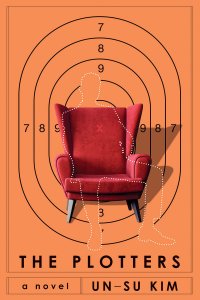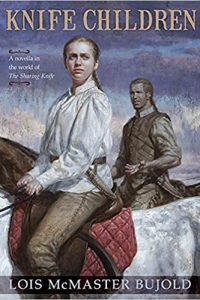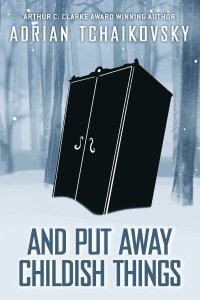Paul Di Filippo Reviews The Plotters by Un-su Kim
 The Plotters, Un-su Kim ((Doubleday 978-0385544382, $25.95, 304pp, hardcover, January 2019)
The Plotters, Un-su Kim ((Doubleday 978-0385544382, $25.95, 304pp, hardcover, January 2019)
The theme of secret conspiracies running our mundane world has sunk deep roots into the genre of fantastika. Although quite often such books exhibit no supernatural or SFnal apparatus, they still manage to evoke speculative or weird effects that resonate with the genre, since they demand a kind of cognitive estrangement: everything you know is wrong. John Crowley recently gave us a new rendering of one of the Ur-texts along these lines: The Chemical Wedding by Christian Rosencreutz. But modern versions go back at least as far as Chesterton’s The Man Who Was Thursday. This type of book was firmly embedded in our magpie genre by the time of Gerald Kersh’s The Secret Masters, which lent its title to fannish conceits. Since then, the number of titles positing hidden deep structures and cabals in our global society is almost uncountable. A grandiose production like The Illuminatus! Trilogy sought to deconstruct the mode while amping it up to eleven. But a thousand heedless thrillers since, as well as more ambitious novels, have nonetheless continued the rich tradition of conspiracy fiction.
The latest one to cross my desk is a streamlined yet superb and deep example: Un-su Kim’s The Plotters. Its theme is that of covert organized assassination-for-hire. And here we establish a connection way back to Jack London’s The Assassination Bureau, Ltd. It’s a powerhouse of a novel, full of melancholy and gore, philosophy and brutality, dark humor and pathos. It reads as if Haruki Murakami rewrote The Day of the Jackal, or as if David Lynch remade Alain Delon’s Le Samouraï, or as if Park Chan-wook reimagined Suddenly (Frank Sinatra as sniper).
Our antihero is a young fellow named Reseng, a killer by trade. He had the misfortune—or fortune—to be raised in the deadly arts from earliest childhood in a place called the Library, under the tutelage of Old Raccoon. (This trope of the child schooled in killing resonates with many icons from the comic book world—Deathstroke and his kids, Hit Girl, even to some degree Batman—and while Kim’s novel is not overtly comic bookish, it still fruitfully deploys subtextual elements of this type.) Old Raccoon is allied with the plotters, providing them assassins. And who are the plotters?
The plotters’ world was one big cartel…. Like any other society, their world had its own strict rules and order. Those rules and order formed the foundation on which the market took shape, and then in streamed the customers.
The plotters are governments, corporations, individuals who need people discreetly bumped off. For this they go to folks like Old Raccoon and his main rival, Hanja, who in turn pass out the assignments to Reseng and his lethal peers. They even farm out corpse disposal, mainly to a lugubrious and loquacious fellow named Bear, who uses his dog-and-cat pet crematorium for nefarious purposes. All very efficient and profitable. Until one individual begins to doubt and question, until certain codes are violated. Then one man can bring the whole structure down in an ultraviolent Armageddon.
The book starts off at a high pitch of tension, and then modulates through an unpredictable succession of quiet and frenzied moments. Reseng is staked out in the wilderness, aiming his rifle at his distant target outside a lonely cabin. But he hesitates to shoot, is later thrown into face-to-face interactions with his victim, and finally fulfills his assignment, nonetheless. All seems business as usual in the end, but it’s not. The seed of doubt has been planted.
From here we get Reseng’s life story in artfully interleaved flashbacks, while the realtime plot—mainly a showdown between Old Raccoon and Hanja, with collateral damage—moves forward. The portrait built up of the man is that of an intelligent, sensitive guy who has been trained to suppress all his finer sentiments and questions of morality, in favor of pure utilitarianism and Darwinian survival. “Reseng had no rules. Not having rules was his only rule.” But somewhere at his core, there’s a hero and even a martyr striving to get out. This aspect will emerge at the fast-paced and riotous climax, a kind of James Cagney-“Top of the world!”-White Heat apocalypse.
But to get there requires several more strange hits, and the transactions of several other characters, mainly his pal Jeongan, Old Raccoon’s information maven; the world’s most accomplished killer, the Barber; and a trio of women—Mito, Misa, and Sunim—who are intent on bringing down the whole infrastructure of the plotters.
Along the way, Un-su Kim raises many intriguing issues and themes, allowing his characters to debate among themselves without authorial decrees. For instance, here’s a major speech from Old Raccoon:
Old Raccoon’s eyes were still turned to the western bank of windows as he said, “The oldest human skull in existence has a hole in it from a spear. Prostitution is a much older profession than farming. The first son in the Bible was also a murderer. For thousands of years, human achievements were only possible through war—including civilization, art, religion, and even peace. Do you know what that means? About the human race? It means that from the very beginning human beings have been plotting to kill one another in order to live. Either by killing their opponents or by leaching off the murderer. That’s how human beings survive. Humanity has always endured this apoptosis, this programmed cell death. It’s the true reality of our world. That’s how we began, and it’s how we’ve lived all this time. It’s probably how we’ll always live. Because no one knows how to stop it yet. And so, in the end, someone ends up playing the role of pimp, prostitute, or hired killer. Funnily enough, that’s what has to happen to keep the wheels turning.”
The reader is forced by the author’s noncommittal objectivity to parse all the philosophical arguments and start asking questions they may never have considered.
But all of that is secondary to the cinematic immediacy and engrossing colorful realism of the action. It’s not only in such balletically violent, heart-grabbing scenes as Reseng’s battle with the Barber, but also in simple conversations—not unmarked by black humor—and other interactions (such as Reseng being healed from his wounds by the trio of women) that Kim’s prose sparkles. Kim (brilliantly translated from the Korean by Sora Kim-Russell) moves among his engaging, thickly limned characters with the ease and insight of a master psychologist and strategist.
Anyone who enjoyed Yoav Blum’s The Coincidence Makers or Max Barry’s Lexicon—or, for that matter, Westlake’s Parker books—will want to hire The Plotters to arrange a hit on their valuable reading hours.
 While you are here, please take a moment to support Locus with a one-time or recurring donation. We rely on reader donations to keep the magazine and site going, and would like to keep the site paywall free, but WE NEED YOUR FINANCIAL SUPPORT to continue quality coverage of the science fiction and fantasy field.
While you are here, please take a moment to support Locus with a one-time or recurring donation. We rely on reader donations to keep the magazine and site going, and would like to keep the site paywall free, but WE NEED YOUR FINANCIAL SUPPORT to continue quality coverage of the science fiction and fantasy field.








